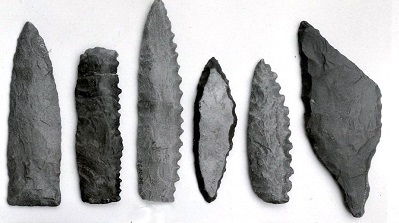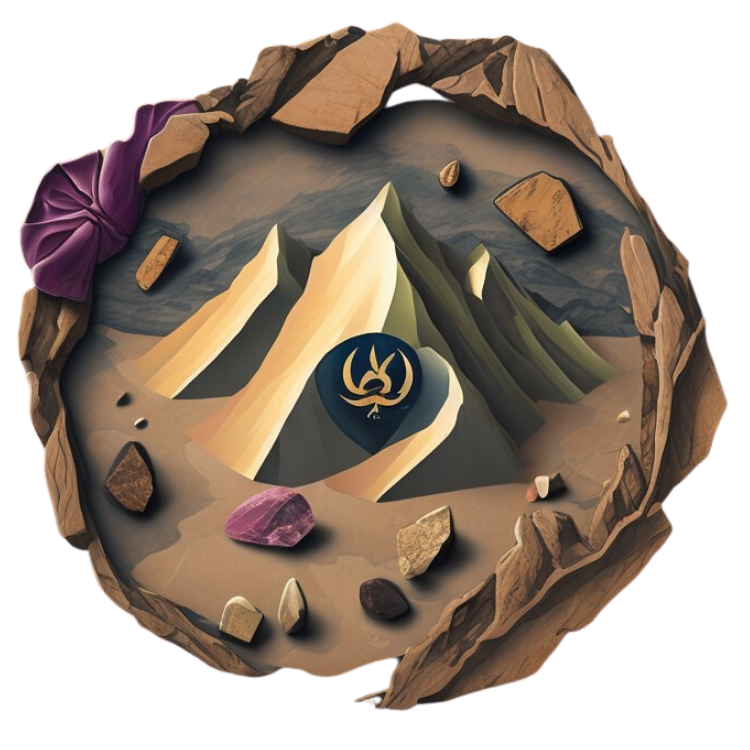Beyond Flint: Exploring the Diverse World of Chert Rocks
Click here to see our crystal hunting maps
Have you ever wondered what the iconic red pyramids of Egypt were built with? The answer might surprise you - a type of rock called chert! Often overshadowed by its close relative, flint, chert boasts a fascinating story waiting to be unearthed. This article delves into the captivating world of chert, exploring its formation, diverse varieties, and its remarkable role throughout history.
An Introduction to Chert
Chert is a fine-grained sedimentary rock primarily composed of silicon dioxide (SiO2), more commonly known as silica. Unlike its close cousin flint, chert encompasses a broader category with a wider range of colors, textures, and formations. Both chert and flint share the characteristic conchoidal fracture - a smooth, shell-like breakage pattern that made them ideal materials for tool creation. However, unlike flint, which is typically a dark gray or black, chert can be found in a dazzling array of colors, often mistaken for gemstones due to its beauty.
In the realm of geology and archaeology, chert plays a crucial role. Its resistance to weathering allows it to preserve valuable information about ancient environments. Fossils trapped within chert offer a glimpse into prehistoric ecosystems, while tools fashioned from chert provide insights into early human technological advancements. Additionally, unlike many other rocks, chert often sheds light on past climates and geological processes.
It's important to dispel some common misconceptions about chert and flint. While both are composed primarily of silica and share similar fracturing properties, flint is a specific type of chert characterized by its dark color and formation in chalk beds. Chert, on the other hand, encompasses a much wider range of varieties, textures, and colors.
The Formation of Chert
The journey of chert begins with the precipitation of silica-rich solutions within sedimentary environments like seafloors or lakes. Microscopic marine organisms such as diatoms and radiolarians contribute significantly to this process, with their silica shells accumulating over time. This accumulation of silica gets compressed and cemented over millions of years, eventually transforming into the dense rock we know as chert.
The primary component of chert is indeed silicon dioxide, but trace minerals can play a crucial role in its formation and appearance. These minerals not only influence the hardness and texture of chert but also contribute to its vibrant color palette. Iron oxides, for example, paint chert red and brown, while manganese lends a distinctive black hue.
Interestingly, the formation of chert can also trap organic materials within its layers. These trapped materials can eventually become fossilized, offering invaluable insights into past life forms. The dense nature of chert acts as a natural preservative, safeguarding these remnants of ancient life for millions of years.
Types of Chert: A Spectrum of Chert Varieties
Chert's diversity shines through its numerous varieties, each with unique characteristics and beauty. Here's a glimpse into some of the most fascinating types:
-
Jasper:
This captivating subtype of chert boasts a microcrystalline structure and typically features an opaque quality. Nature's paintbrush truly comes alive in jasper, with its vast array of colors ranging from fiery reds and sunny yellows to deep greens and calming blues. Hematite inclusions contribute to the fiery reds and oranges, while other minerals like chlorite and manganese lend jasper its green and black hues. Jasper's exceptional hardness makes it a popular choice for crafting cabochons (polished gemstones) and other ornamental objects.
-
Chalcedony:
Often translucent or semi-transparent, chalcedony exhibits a waxy luster and boasts a captivating color palette. Unlike Jasper's opaque nature, chalcedony allows light to pass through, revealing its inner beauty. This variety can be found in a mind-boggling array of colors, including white, gray, blue, and even purple. The presence of chalcedony within other rock formations can create mesmerizing patterns and textures, like the captivating moss agate, where green inclusions resemble moss trapped within the stone.
-
Agate:
A true collector's gem, agate is a captivating variety of chalcedony renowned for its mesmerizing patterns. Layers of chalcedony in various colors create concentric bands or even intricate fortification patterns within the stone. These captivating formations are a result of repeated cycles of deposition and dissolution of silica-rich solutions. The resulting agate slices, often polished and displayed, resemble breathtaking landscapes in miniature. Carnelian agate, with its fiery red hues, is a particularly prized variety.
-
Flint:
As we know, flint is a specific type of chert characterized by its dark gray or black color and formation within chalk beds. Its exceptional conchoidal fracture made it the go-to material for toolmaking throughout history. From spear points to knives, flint played a crucial role in human technological advancement for millennia.
-
Porcelanite:
Imagine a rock with a smooth, almost porcelain-like texture and a light-colored appearance. That's porcelanite for you! This chert variety often forms from volcanic ash deposits rich in silica. Its fine-grained texture and light color make it a suitable material for use in ceramics and certain industrial applications.
-
Novaculite:
For those seeking a truly exceptional chert variety, look no further than novaculite. Renowned for its exceptional hardness and fine-grained texture, novaculite was a highly prized material for crafting razor-sharp tools by early civilizations. The Ouachita Mountains in the southern United States boast some of the world's finest novaculite deposits, where Native American cultures utilized it extensively for toolmaking.
Beyond these prominent varieties, the world of chert offers even more diversity:
- Radiolarite: This chert variety contains a significant amount of microscopic skeletal remains of radiolarians, single-celled marine organisms. The presence of these radiolarian tests can give radiolarite a reddish or brownish color.
- Ferruginous Chert: As the name suggests, this type of chert is rich in iron oxides, lending it a distinctive reddish-brown hue. Ferruginous cherts are often found associated with banded iron formations, a type of rock sequence rich in iron.
- Jaspillite: This captivating rock combines the beauty of jasper and the iron-rich nature of banded iron formations. Jaspillite showcases alternating bands of red jasper and black iron oxides, creating a visually striking rock formation.
This list merely scratches the surface of the remarkable diversity within the chert family. From the vibrant hues of jasper to the intricate patterns of agate, each variety tells a unique story about its formation and geological history. As we continue to explore the world of chert, discoveries, and classifications might further expand our understanding of this fascinating rock.
Beyond color variations, chert showcases a diverse range of textures. Some varieties are smooth and uniform, while others exhibit banded patterns or even a brecciated (fragmented) appearance. Oolitic chert, for example, features a unique texture composed of rounded grains resembling fish eggs.
RELATED TOPIC: Reddish Rocks: A Journey through Reddish Rock Formations and Properties
Chert in Human History

Chert transcends its role as a mere rock; it transforms into a captivating canvas upon which the story of humanity unfolds. Its remarkable properties, particularly the conchoidal fracture that allows for precise shaping, propelled chert to the forefront of human technological advancement for millennia.
-
Early Tools and the Dawn of Technology: Imagine the ingenuity of early humans crafting tools from readily available materials like chert. Its hardness and ease of shaping made it ideal for crafting spear points, arrowheads, and knives - essential implements for hunting, gathering, and self-defense. Chert empowered early humans to become more efficient hunters, contributing to their survival and eventual flourishing.
-
Beyond Utility: Chert's Cultural Significance: The story doesn't end with tools. Chert's aesthetically pleasing varieties, like jasper and chalcedony, found their place in the cultural realm. These vibrant stones were fashioned into ornaments, beads, and ceremonial objects, reflecting the artistic expression and symbolic value held by different cultures. Polished pieces of chert might have held spiritual significance or served as markers of social status.
-
A Window into the Past: Fossils Preserved in Chert: Chert's remarkable ability to preserve fossils offers a glimpse into the vibrant tapestry of life on Earth millions of years ago. Plant and animal remains trapped within chert layers become perfectly fossilized, providing invaluable information about past ecosystems. These fossilized remnants act as a time capsule, revealing the diversity of life forms that coexisted with the very rock that now safeguards their story.
-
Nature's Artistic Palette: Chert's Breathtaking Beauty: Imagine a rock that transcends its utilitarian purpose and becomes a canvas for nature's artistry. Mineral inclusions and unique banding patterns within chert can create breathtaking landscapes, captivating collectors and artists alike. These aesthetically pleasing varieties, often polished and displayed, serve as a testament to the beauty hidden within the earth. Chert serves as a reminder of the exquisite artistry woven into the very fabric of our planet.
Modern Uses of Chert: From Ancient Tool to Modern Marvel
While chert's role in toolmaking might have diminished, it continues to hold surprising significance in the modern world. Its diverse properties have ensured its reach extends far beyond the realm of prehistoric campsites. Let's explore the multifaceted ways chert continues to impact our lives:
-
Chert's Industrial Applications: Chert's journey from ancient tools to modern marvel begins in the industrial sector. Its hardness makes it a valuable abrasive, utilized in grinding compounds and polishes. Crushed chert finds a new life as a construction material, forming the base for roads and other infrastructure projects. The durability and stability of chert make it a reliable choice for these demanding applications.
-
Chert in the Ceramic and Paint Industries: Chert's versatility extends beyond its mechanical properties. The ceramic industry utilizes specific chert varieties for their unique chemical composition. These properties can contribute to the strength, texture, and overall quality of ceramic products. Similarly, the paint industry finds certain chert varieties beneficial due to their ability to act as extenders or fillers, improving the performance and cost-effectiveness of paints.
-
Chert's Allure in Jewelry: Chert's story takes a captivating turn when we explore its role in the world of gemstones. Certain varieties, particularly jasper and chalcedony, with their vibrant colors and captivating patterns, are highly sought after for use in jewelry. These beautiful stones, meticulously cut and polished, become stunning earrings, pendants, and other adornments. Chert jewelry adds a touch of natural beauty and a connection to the earth's history to modern fashion.
-
Chert and Scientific Research: Chert's significance extends beyond aesthetics and industry. Scientists utilize chert formations as a valuable tool for studying past climates and geological processes. By analyzing the composition and structure of chert, researchers can glean insights into the environmental conditions millions of years ago. The microscopic organisms trapped within chert layers can offer clues about the temperature, salinity, and overall ecosystem of ancient seas. Additionally, the presence of specific minerals within chert can shed light on the geochemical makeup of these past environments.
-
The Enduring Allure of Chert: For collectors and enthusiasts, chert continues to be a captivating subject. Unique and aesthetically pleasing varieties, like agates with their intricate banding patterns or jaspilite with its contrasting red and black hues, are prized possessions displayed in collections worldwide. The hunt for these natural treasures, each with its own story to tell, keeps the fascination with chert alive for a new generation.
Chert Deposits Around the World
Chert's presence isn't confined to a single location; it's a citizen of the world, found scattered across continents, each region boasting its unique characteristics. Let's embark on a geographical adventure to discover some of the most notable chert hotspots:
Europe: A Legacy of Chalk and Chert
- The United Kingdom: The iconic white cliffs of Dover are a testament to Europe's rich chert heritage. These cliffs are composed primarily of Cretaceous chalk, a sedimentary rock formation that often contains dark nodules of flint, a specific type of chert. These flint nodules were extensively utilized by prehistoric Britons for crafting tools and weapons.
- France: Similar to Britain, France boasts significant deposits of Cretaceous chalk formations containing flint. The Dordogne Valley, a UNESCO World Heritage Site, is renowned for its prehistoric cave paintings, many of which were created using tools fashioned from flint.
North America: A Continent Painted in Chert
- The Midwestern United States: This region is a treasure trove for chert enthusiasts. Colorful varieties like jasper and chalcedony can be found in abundance, particularly in states like Ohio, Indiana, and Missouri. The Mississippi Valley is particularly famous for its colorful cherts, often sought after by collectors and lapidaries (gemstone cutters).
- The Great Plains: Travel west to the Great Plains region, and you'll encounter a different type of chert story. Here, sedimentary rocks of the Pennsylvanian period, millions of years old, often contain chert formations. These cherts can be brown, gray, or even black, and were utilized by Native American cultures for toolmaking.
- The Southwestern United States: This arid region boasts a unique chert story. Here, volcanic activity has played a significant role in chert formation. Deposits of chalcedony and petrified wood, a type of chert that replaces wood fibers, can be found in abundance, particularly in Arizona and New Mexico. The vibrant colors and captivating textures of these cherts make them highly prized by collectors and artists.
Beyond the West: Chert's Global Reach
- Australia: Journey down under to discover Australia's rich chert deposits. The Carnarvon Basin, located in Western Australia, is renowned for its exceptional banded iron formations containing chert. These formations showcase alternating layers of red jasper and black iron oxides, creating a visually stunning geological spectacle.
- South Africa: Africa's chert story unfolds in countries like South Africa. The Drakensberg Mountains hold deposits of banded iron formations similar to those found in Australia, showcasing the global presence of this unique chert type.
- South America: Even South America boasts its share of chert riches. The Brazilian Shield, a vast ancient craton (stable continental core), contains a variety of chert formations, including some associated with banded iron formations.
This list merely scratches the surface of chert's global distribution. From the rolling plains of North America to the rugged mountains of South Africa, chert's presence tells a story of geological processes at work across the globe. As exploration and research continue, new chert deposits with unique characteristics might be discovered, further enriching our understanding of this fascinating rock.
Challenges and the Future of Chert Research
Despite the wealth of knowledge surrounding chert, some challenges persist. Differentiating between various chert types can be difficult due to their overlapping characteristics. Additionally, the debate over the origins of chert continues, with some arguing for a purely chemical formation process and others advocating for the significant role of biological activity.
Future research holds immense potential for unlocking further secrets about chert. Advanced analytical techniques might shed light on the precise formation processes and the environmental conditions that led to the creation of specific chert varieties. Additionally, the study of fossils preserved within chert could offer new insights into the evolution of life on Earth.
Conclusion
Chert's journey, from its formation in ancient seas to its diverse applications throughout history, is a captivating tale. This seemingly ordinary rock boasts a remarkable story, showcasing its significance as a valuable material for tool creation, cultural expression, and scientific study. As research delves deeper, the world of chert promises to unveil even more fascinating secrets, leaving us in awe of nature's ingenuity.
The future of chert research holds exciting possibilities. Who knows what groundbreaking discoveries await us as we continue to explore this captivating rock and its role in shaping our planet's history?
